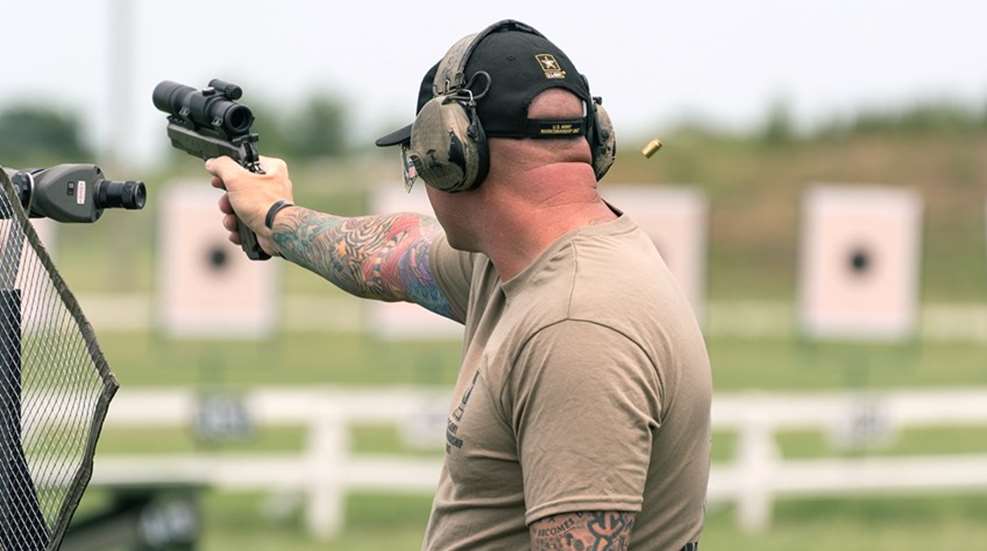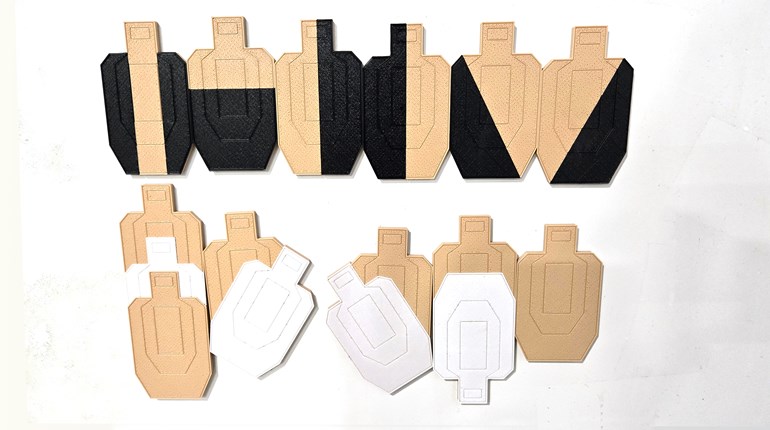
From the December 2008 issue of Shooting Sports USA.
Develop a regimented training program during the winter months to give yourself a leg up on the competition. When winter weather closes the range, follow these easy drills in the comfort of your own home for a tighter shot group, better hold, smoother trigger squeeze and faster target acquisition.
Holding Drill―Horizontal Line
First, take a note card or blank target and draw (or use duct tape) a thick horizontal line across the page. Next, place the target about eye level when in the shooting position. (If doing this drill at the range, send the target to 10, 25 or 50 meters.) Step away from the wall just enough so the muzzle doesn’t tough the paper. Bring the firearm up and hold the sights on the line, making every effort to prevent the sights form moving up and down. The duration of hold is dependent on the physical ability of the shooter. Start with short periods of time and increase the duration as ability improves. Complete five to 10 repetitions (one set) of this exercise, taking a 15-minute break between sets.
Holding Exercise
Post a piece of paper or target “down range,” then get into firing position and hold on target. Try to move as little as possible for the duration of the hold. Again, holding times differ depending on the physical condition of the shooter. Start with 30 seconds and move up to one minute. Try to think of slowing the arc of movement down as much as possible. Remember to breathe while continuing to work on the endurance of the arm. This exercise is excellent for conditioning in the off-season.
Holding Drill―Vertical Line
For this drill you will need a note card or blank target with a vertical line on it (use marker or duct tape). Either place the target on a wall at eye level or send down range to 10, 25 or 50 meters. When using a note card in a safe environment, ensure the line is at the same height as it would be on the range using a regular target (about eye level). Bring the firearm up into position and hold the sights on the line, making every effort to prevent the sights from moving left or right. The duration of hold is dependent on the physical ability of the marksman. Shooters should start with a short period of time increasing the duration as ability improves. Complete five to 10 repetitions (one set) of this exercise, taking a 15-minute break between sets.
Holding Drill―Plus Sign
Start this exercise by drawing a “plus” sign on a square note card or blank target. The middle of the plus should be at the center of the paper. Place the note card on the wall, or at the desired distance. When using a note card in a safe environment, ensure the center of the plus is at the same height as it would be on the range using a regular target. Bring the firearm up into position and hold the sights on the center of the target, making every effort to prevent the sights from moving up, down, left or right. The size of the movement represents the arc of movement the shooter can expect to see during training and competition. The duration of hold is, once again, dependent on the physical ability of the shooter. Start with short periods of time and increase the duration as ability improves. Do five to 20 repetitions (one set) of this exercise, taking a 15-minute break between sets.
Moving Front Sight
In this drill the shooter should imagine their front sight is on a rail, and as they apply pressure on the trigger the front sight moves toward the rear sight. Since the front sight is on a rail, the sights should remain aligned at all times. The idea here is to keep the shooter’s mind occupied with the sights and trigger pressure so they stay focused on the shot delivery. This drill will aid the shooter in becoming more acquainted with the front sight and trigger pressure. Another aspect of this drill is to remove any match pressure by moving the shooter’s concentration to the shot process.
Dot Drill
Draw a round black dot on the back, center of a full-faced target or piece of paper the same size; or draw a dot similar in size to that of the viewing size of the target at the distance prescribed. (The size of the dot when the paper is placed at the desired distance should mimic the size of the black of the target in mind.) Place the paper at eye level on the wall, or send the target down range. Then, using the dot as the aiming area, dry fire slow fire shot groups on the dot without the distraction of keeping score after each shot.
Countdown Shot Drill
Using the same dot as in the Dot Drill above, the shooters should raise his or her firearm into position and, after the shooter’s arc of movement has settled, they should start counting down from five, descending at an even pace to one. As the numbers decrease, the pressure on the trigger should increase. If the shot has not broken by the count of one, the shooter should lower the gun, pause for 20 seconds and begin again.
Small Dot Holding Exercise
Using a note card, place a tiny dot in the center of the paper, then tape the page to the wall at the eye level of the shooter. The shooter should position themselves so the muzzle of the gun is slightly off the paper. While attempting to hold the sights on the dot, the shooter should make every effort to slow down the movement as the front sight passes the dot. A small dot allows the shooter to check the amount of movement he or she is experiencing, and to strive to limit this movement. The larger the dot, the less movement is perceived.
Off Target First Shot Drill (for disciplines requiring quick sight/target acquisition)
During this exercise the shooter sets up a target, but only for reference; the drill takes place just off the target. On command, or signal, the shooters should lift the firearm quickly to a point just below the center of the imaginary target (where the bottom of the berm would be, or just below the center of the target). As the gun reaches that point, the shooter should begin to obtain sight alignment while beginning to squeeze the trigger. As the sights are aligned and trigger squeeze begins, the gun should slow and slide into the center of the target. The shot should break as the center of the target is reached. If the shot is not fired at that point, the shooter should continue to squeeze the trigger and wait for the shot to break. Quick and smooth movement is necessary during this drill.
Dry Fire Buddy Assist
On a normal target, or dot the equivalent size as the prescribed target at the firing distance, the shooter should dry fire as usual. This time however, while in the firing position, an assistant or “buddy” should work the slide of the gun while the shooter continues to dry fire to simulate recoil. The buddy is looking for any movement when the hammer falls, as is the shooter. This drill is a good way of getting dry fire training in timed and rapid fire. The shooters train not only in dry fire, but recoil control and recovery back to the holding area.
Trigger Improvement
This shooter should be looking to improve trigger squeeze without disturbing the sights or hold in this drill. Place a dot on the wall the size of a pencil tip. This dot will be used as a reference point for how fast the shooter’s sights move past the point. Without cocking the pistol, the shooter should hold on the dot and squeeze the trigger as fast and smooth as they can without disturbing the front sight. The idea is to squeeze the trigger as many times as possible in one hold. Each hold should be at least 30 seconds long.
Irregular Pause
While dry firing a match format, the shooters should insert a predetermined time of rest after every predetermined number of shots. (i.e. After the first series of five shots, wait seven minutes before starting the next series. On the next set of shots, wait 11 minutes, and so on.) The idea behind this exercise is to teach the shooter to perform on demand and not always in the normal, consistent conduct o fa match. Things happen that often prolong a match, therefore this drill can help shooters develop a strategy to overcome an unfamiliar situation.
Editor’s note: Always exercise safety when training: keep the gun pointed in a safe direction, keep the gun unloaded until ready to use, keep your finger off the trigger until ready to shoot and complete these exercises in a designated safe area.



































